
Krikor (Gregor) Djololian
Studio AraxArax was devoted to bodybuilding and for forty years - spanning from the mid-thirties until the mid-seventies - his pictures were amongst the most popular in physical culture magazines. Arax would travel to most major competitions in Europe and always produced good on-the-spot pictures although the conditions were far from ideal for photography.
It was in his studio in the Boulevard Raspail, however, that he came into his own with the subtle lighting which emphasized the muscularity of his subjects, rather than the art of the photographer. He shunned over dramatic studies, fancy backgrounds, intriguing props, or complicated compositions - the physique alone was what mattered to Gregor and he was extremely careful with every picture he took.
A Tribute to Gregor Arax
Physique in Focus, ca. 1977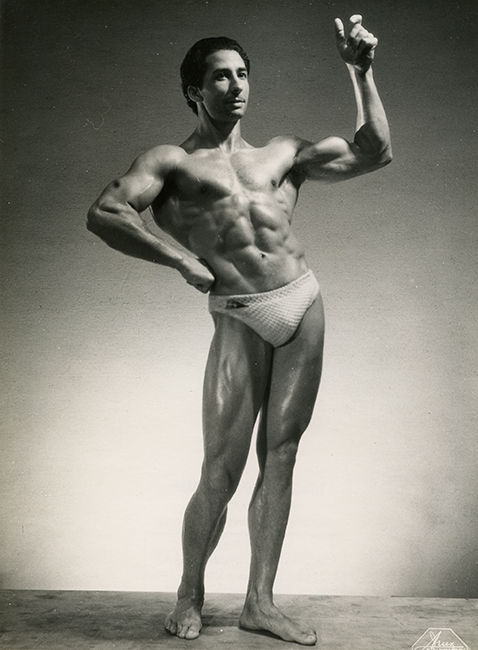 Juan Ferrero, Paris, 1948. Spanish bodybuilder from Bordeaux, France (1918-1958)
Juan Ferrero, Paris, 1948. Spanish bodybuilder from Bordeaux, France (1918-1958)
“Mr. Universe,” London, 1952
Studio Arax
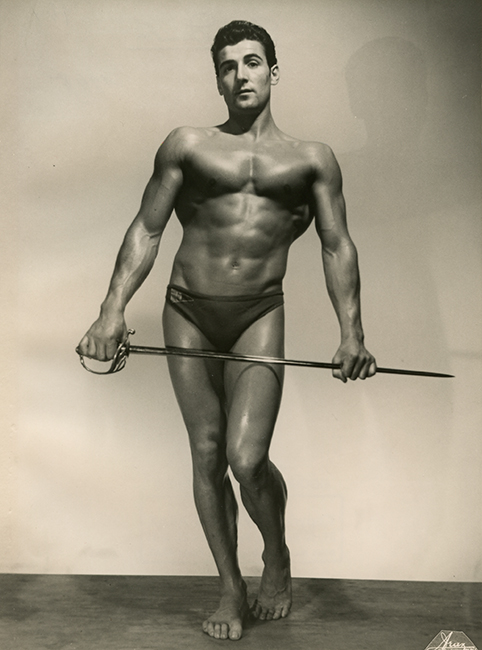
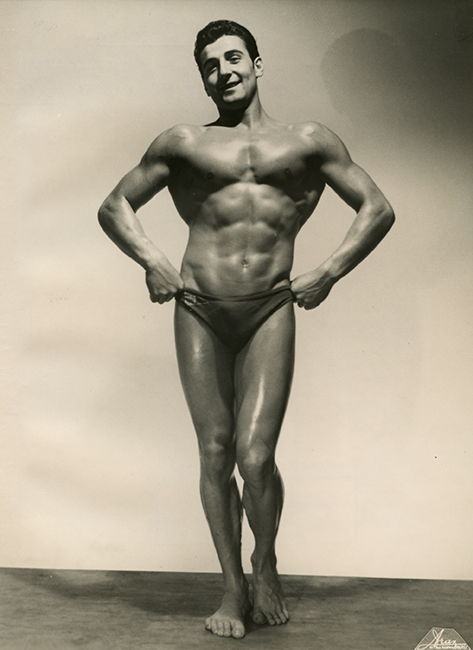
Royo Danilo, Second Class, “Best Athlete Ile-de-France, 1948”
Studio Arax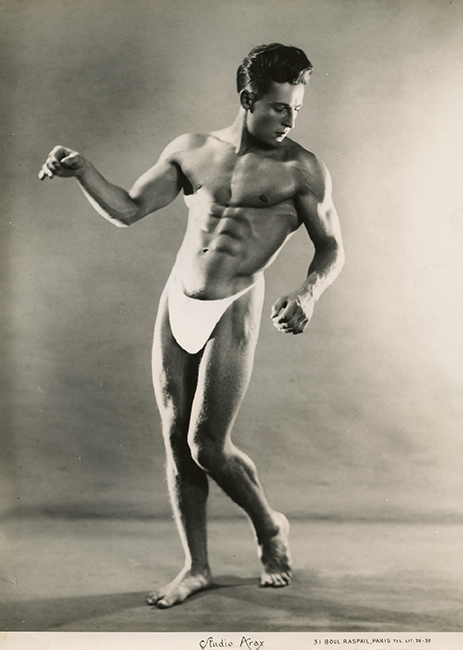 Guy Broguerie, Paris, February 28, 1946
Guy Broguerie, Paris, February 28, 1946
Studio Arax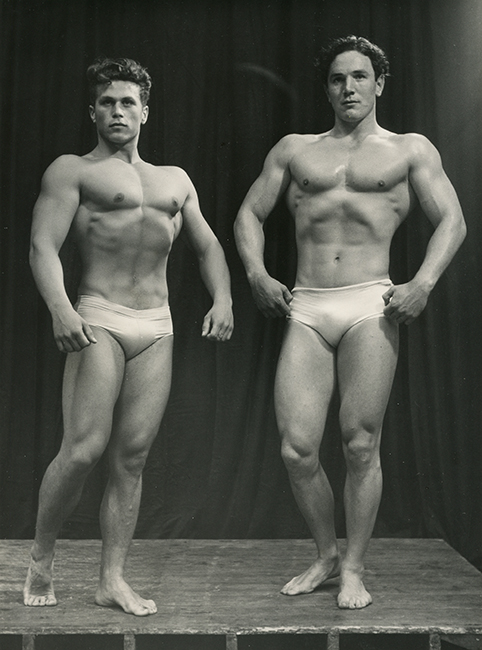 Charles Klejniak (Belgium) and Hubert Thomas (England)
Charles Klejniak (Belgium) and Hubert Thomas (England)
London, June 24, 1954
Studio Arax Arthur Robin, Paris, 1957
Arthur Robin, Paris, 1957
Studio Arax
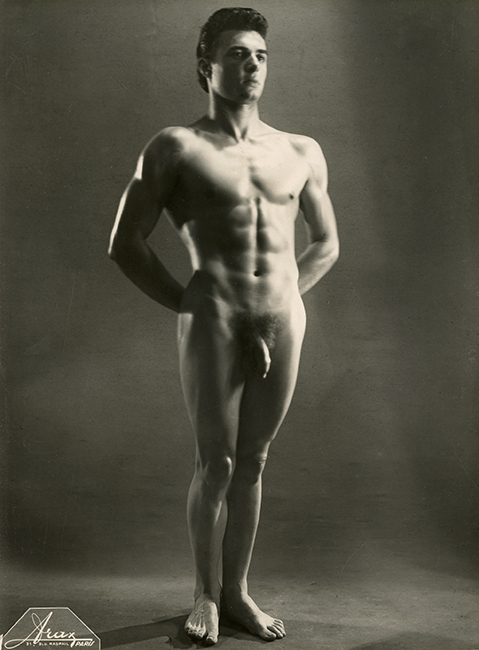
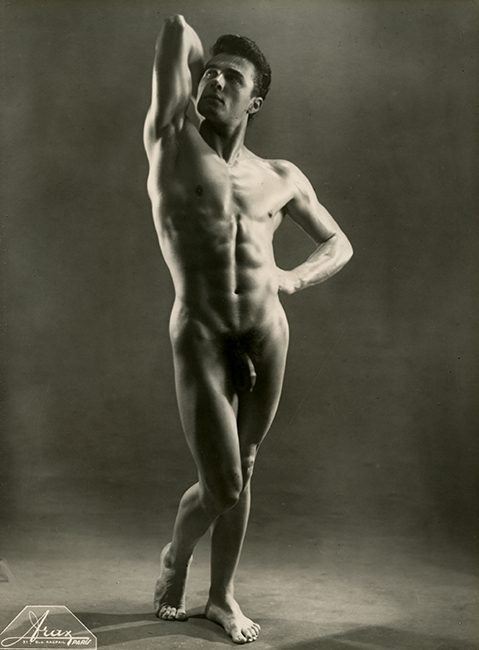
Jean Merlier, Paris, 1946
Studio Arax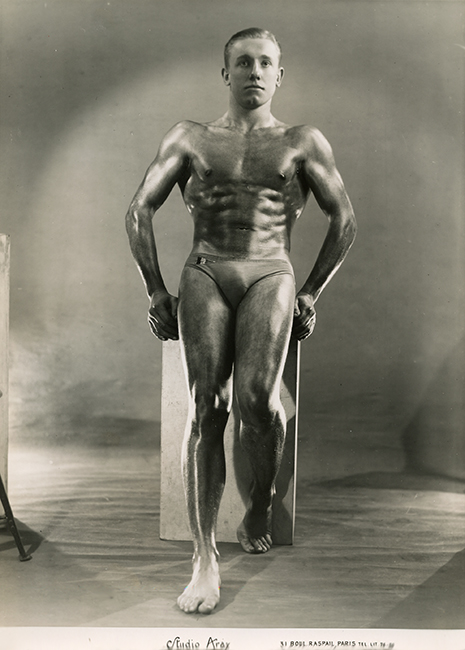 Pierre Druart, Paris, 1947
Pierre Druart, Paris, 1947
Studio Arax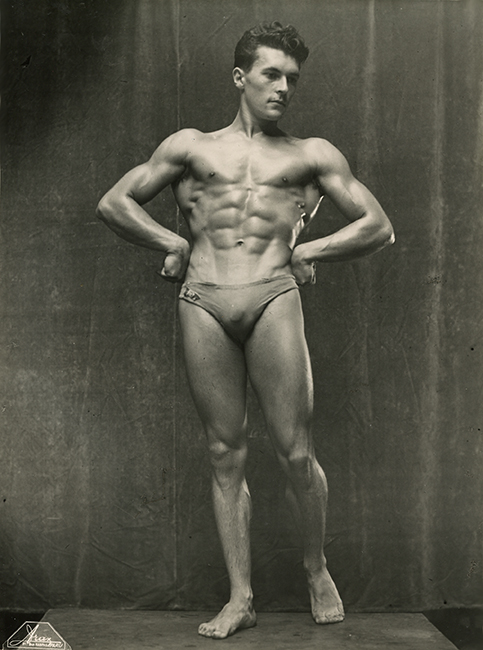 Bernard Chateau, “Best Athlete of France,” Paris, 1947
Bernard Chateau, “Best Athlete of France,” Paris, 1947
Studio Arax James Mathe, Paris, France, February 16, 1955
James Mathe, Paris, France, February 16, 1955
Studio Arax

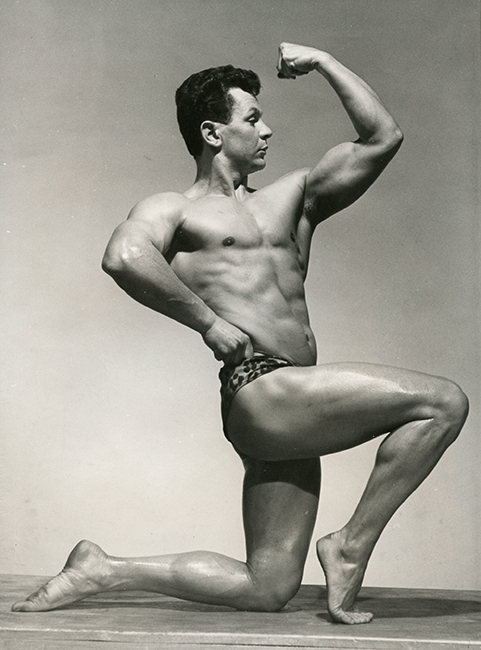
James Mathe, Paris, February 16, 1955
Studio Arax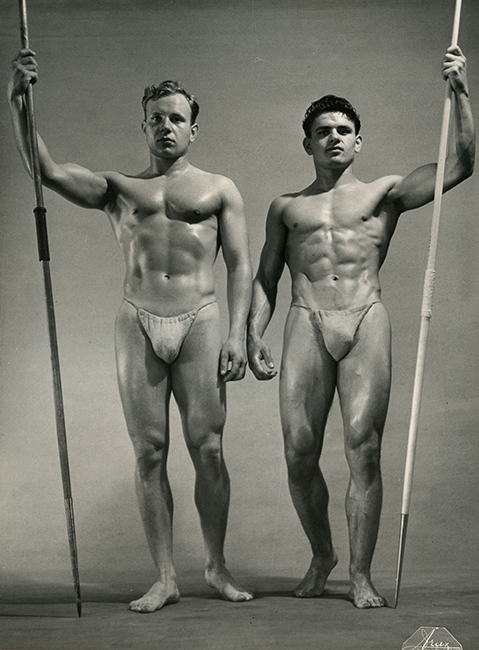 Albert Struys (left) and Gerard Ferket (right), Antwerp, Belgium, May 17, 1951
Albert Struys (left) and Gerard Ferket (right), Antwerp, Belgium, May 17, 1951
Studio Arax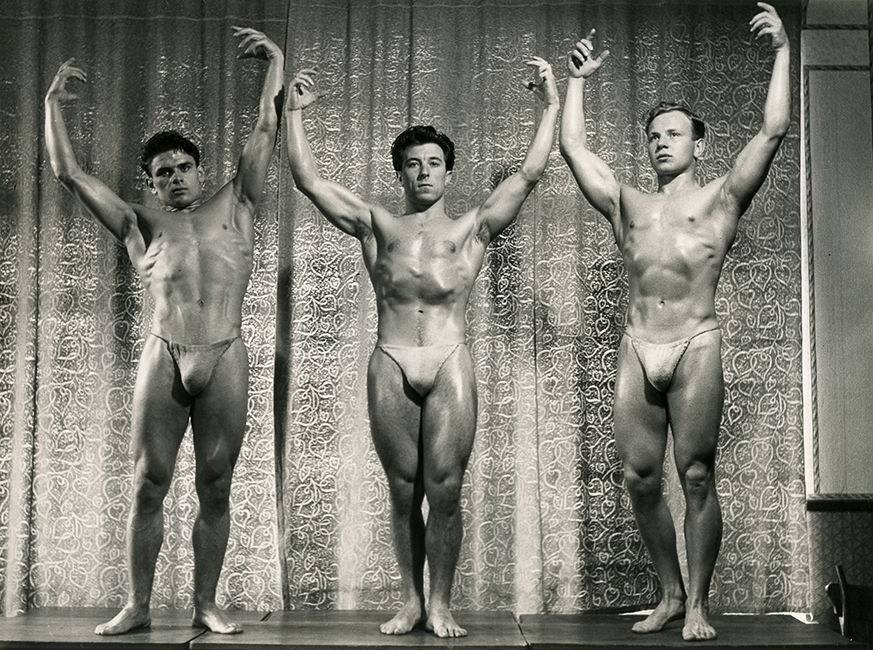 Gerard Ferket (left), and Albert Struys (right). Antwerp, Belgium, May 17, 1951
Gerard Ferket (left), and Albert Struys (right). Antwerp, Belgium, May 17, 1951
Studio Arax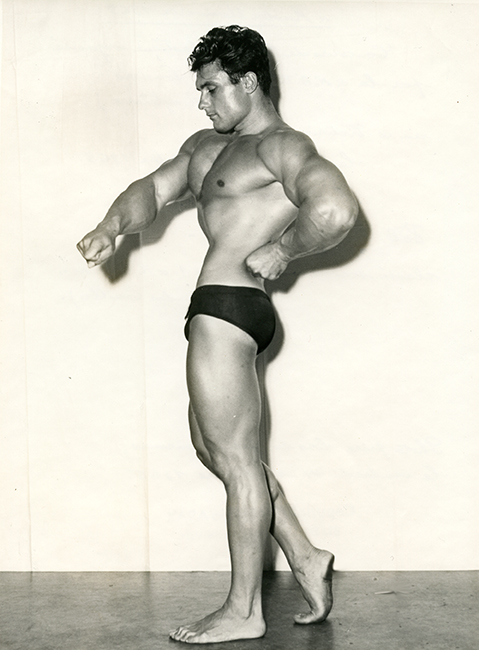 Val Vasilieff, “Mr. America, 1964”
Val Vasilieff, “Mr. America, 1964”
London, September 25, 1965
Studio Arax
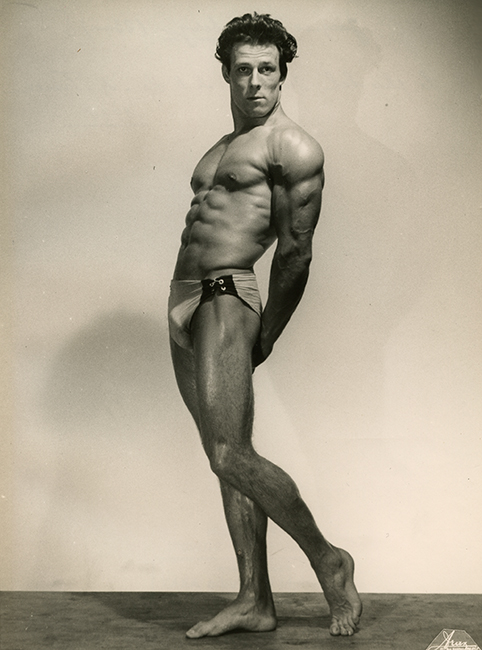
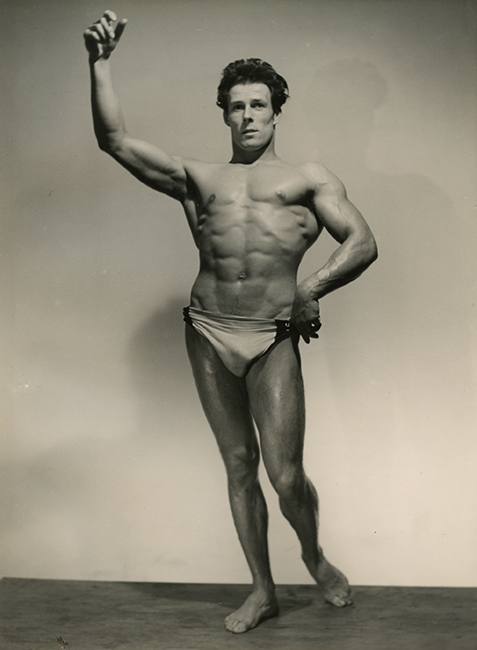
Jacques Weinsberg, First class, “Best Athlete of Ille-de-France, 1948”
Studio Arax Rene Percigou, “Mr. France, 1943” (4th),
Rene Percigou, “Mr. France, 1943” (4th),
“Mr. France, 1946” (3rd), “Mr. France, 1948” (4th)
Studio Arax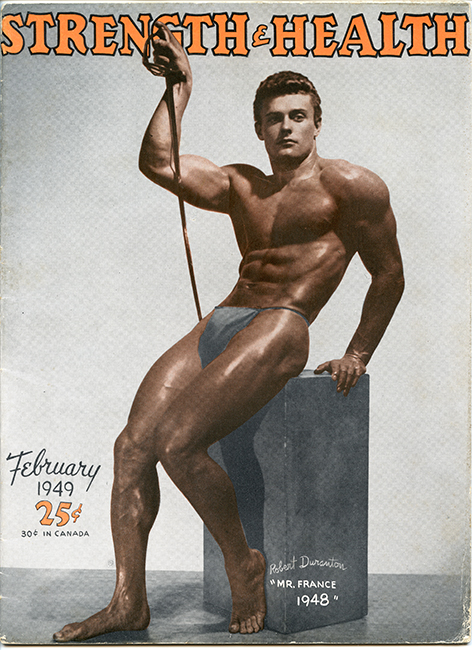 Robert Duranton, “Mr. France, 1948”
Robert Duranton, “Mr. France, 1948”
Strength & Health Magazine
Cover Photo by Studio Arax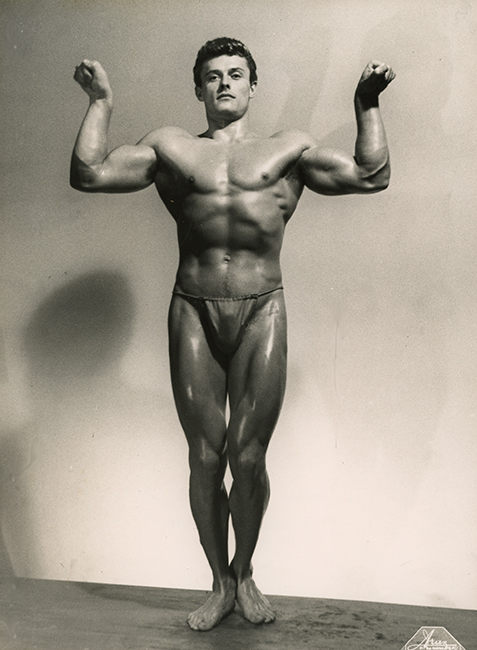 Robert Duranton, Paris, 1948
Robert Duranton, Paris, 1948
Studio Arax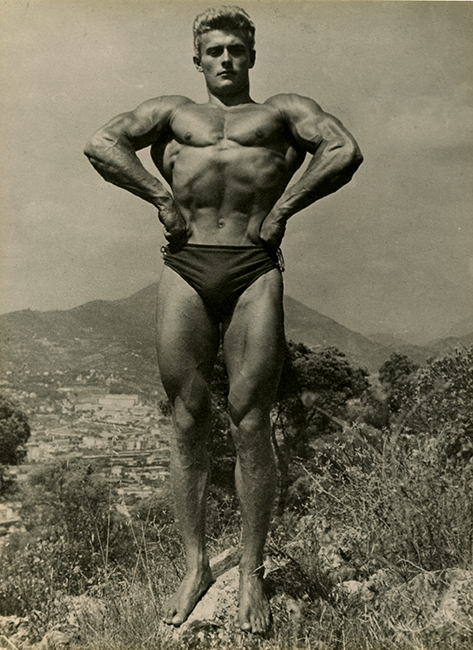 Robert Duranton, Cannes, France, August, 1948
Robert Duranton, Cannes, France, August, 1948
“Most Beautiful Athlete of France, 1948”
Studio Arax
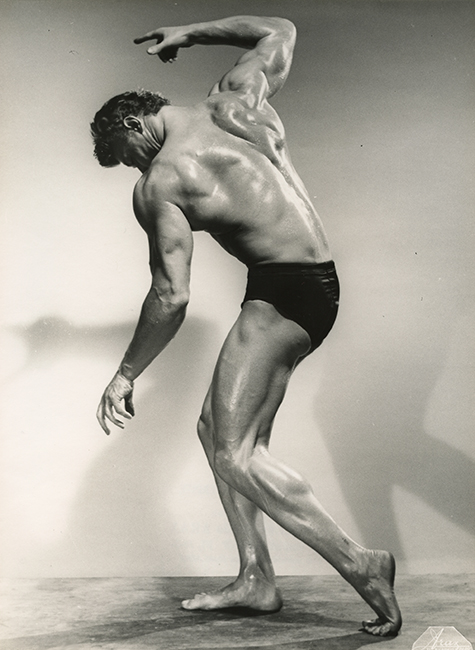
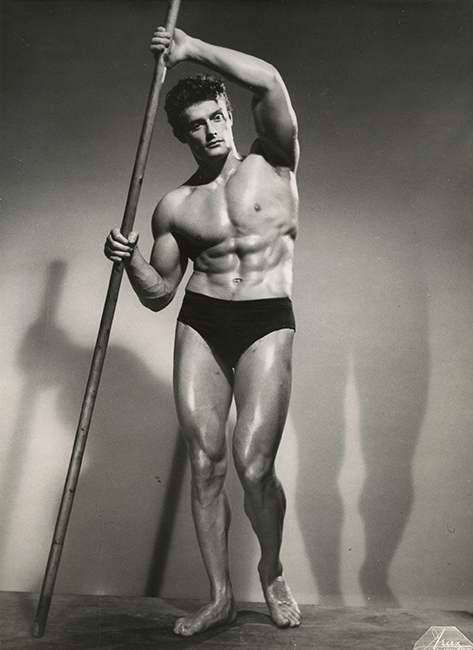
Robert Duranton, Paris, 1949
Studio Arax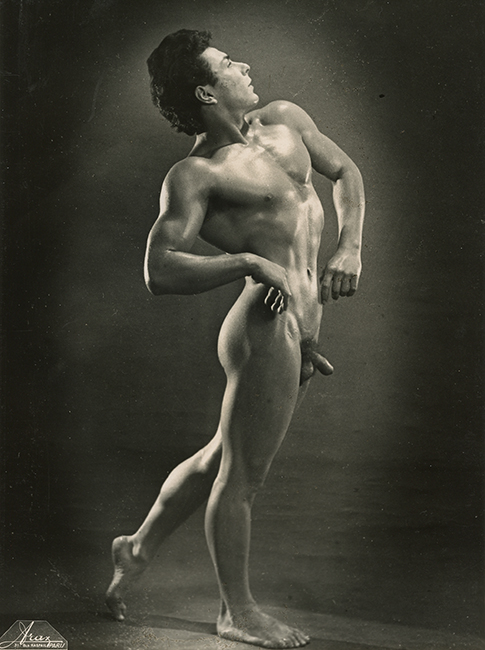 Marcel Guillou, Paris, ca. 1950
Marcel Guillou, Paris, ca. 1950
Studio Arax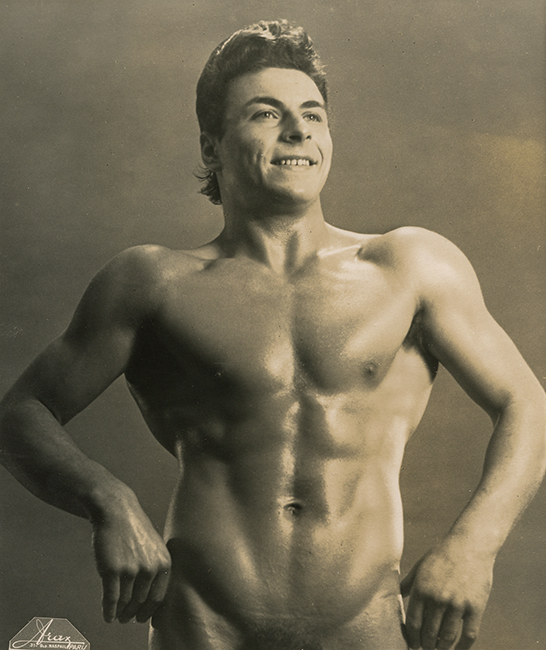 Marcel Guillou, Paris, 1959
Marcel Guillou, Paris, 1959
Studio Arax

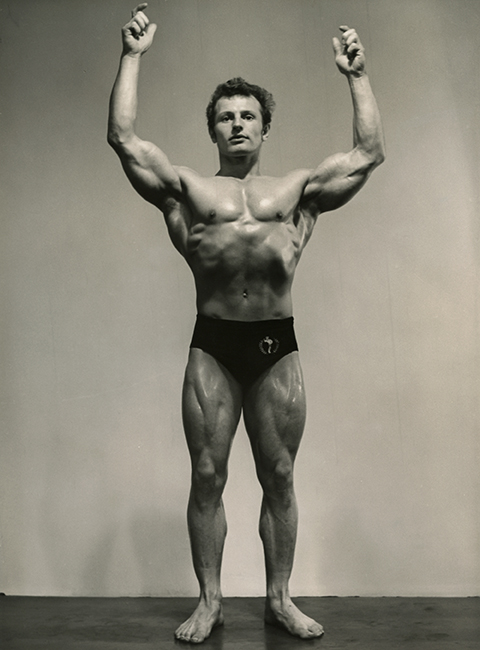
Gaston Sagaert (Belgium), Brussels, March 2, 1952
Studio Arax
John Citrone (England), Paris, June 4, 1966
Studio Arax
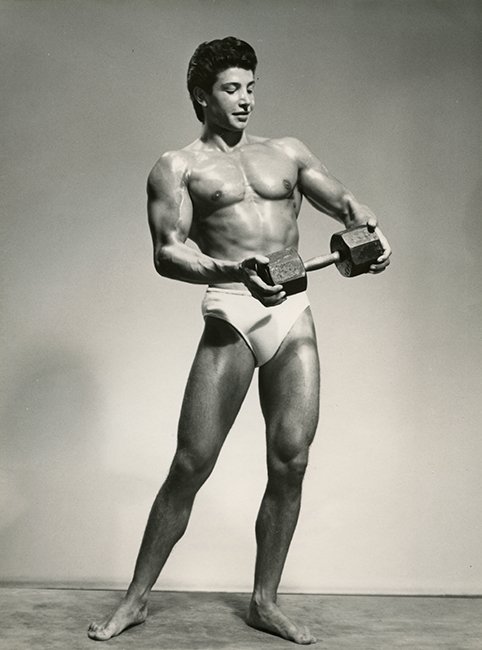 Charles Kassapian, Paris, August 30, 1955
Charles Kassapian, Paris, August 30, 1955
Studio Arax
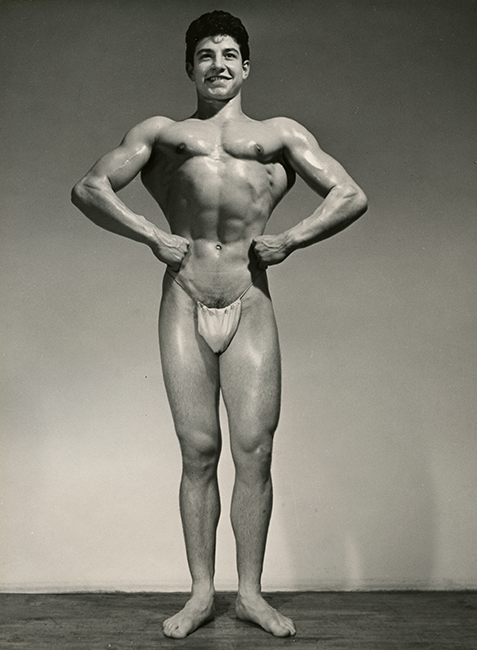

Charles Kassapian, Paris, March 8, 1952
Studio Arax
Charles Kassapian, Paris, October 14, 1955
Studio Arax
 Yan Larvor, Trouville, France
Yan Larvor, Trouville, France
July 31, 1954 and August 1, 1954
Studio Arax Yan Larvor, Paris, November 15, 1960
Yan Larvor, Paris, November 15, 1960
“Mr. Apollo, 1954,” (Tall category)
Studio Arax
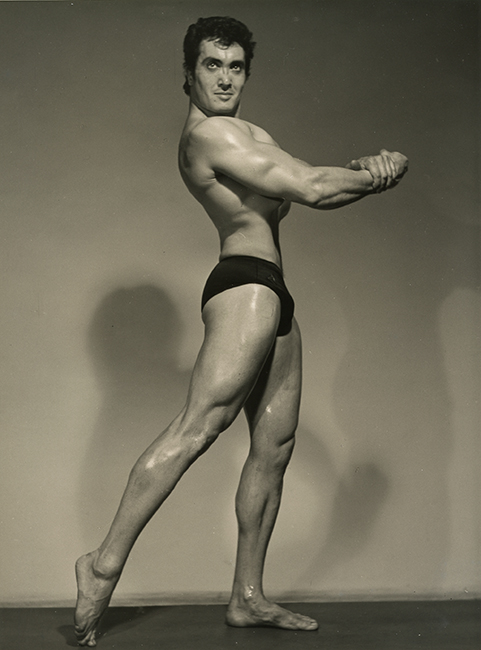
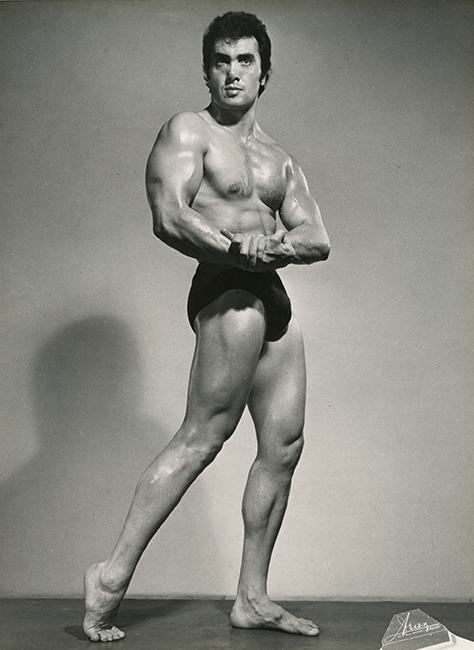
Yan Larvor, Paris, 1959
Studio Arax
Yan Larvor, Paris, November 15, 1960
Studio Arax

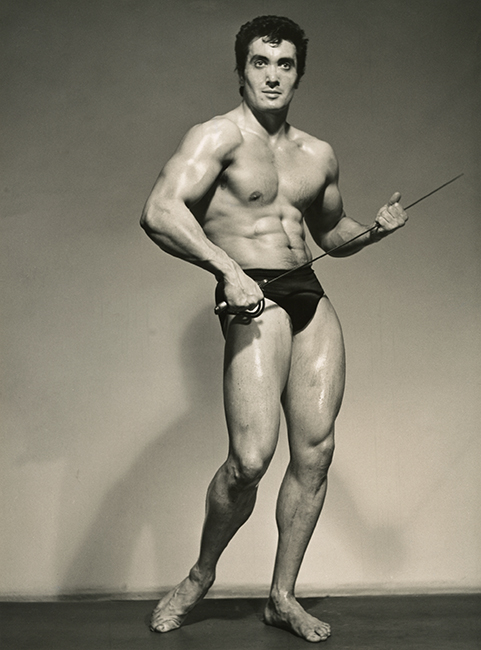
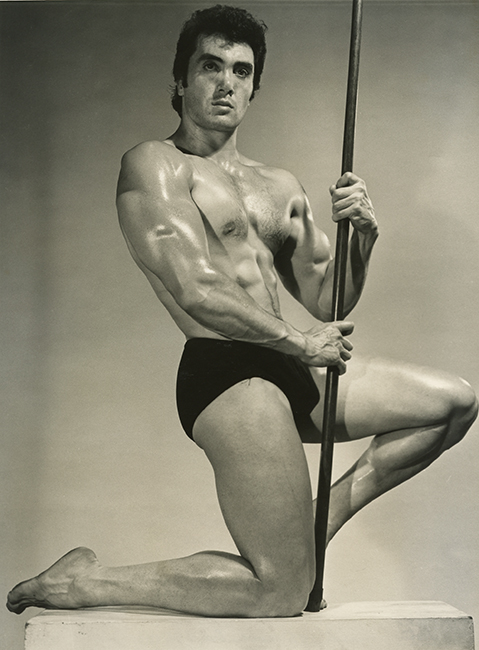
Yan Larvor, Paris, Arpril, 1959
Studio Arax
Yan Larvor, Paris, November 15, 1960
Studio Arax



Hubert Thomas (Wales), Paris, March 25, 1949
“Mr. Britain, 1951”
Studio Arax
James Marcel, Paris, 1959
Studio Arax


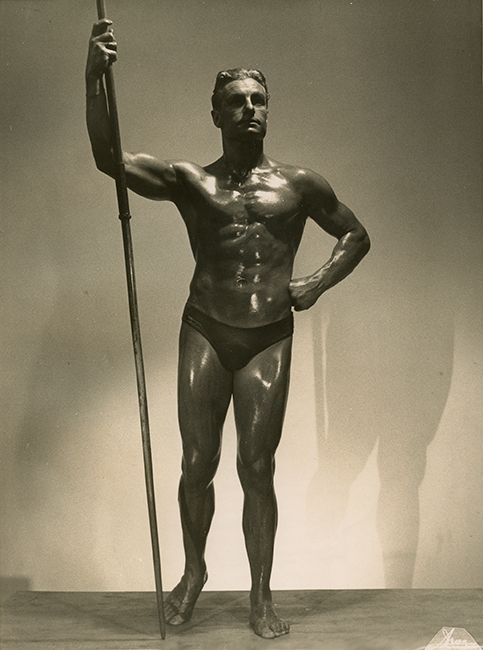
Roger Valino, Paris, 1947
Studio Arax
 Hubert Lesage, Nice, France, August 1956
Hubert Lesage, Nice, France, August 1956
Studio Arax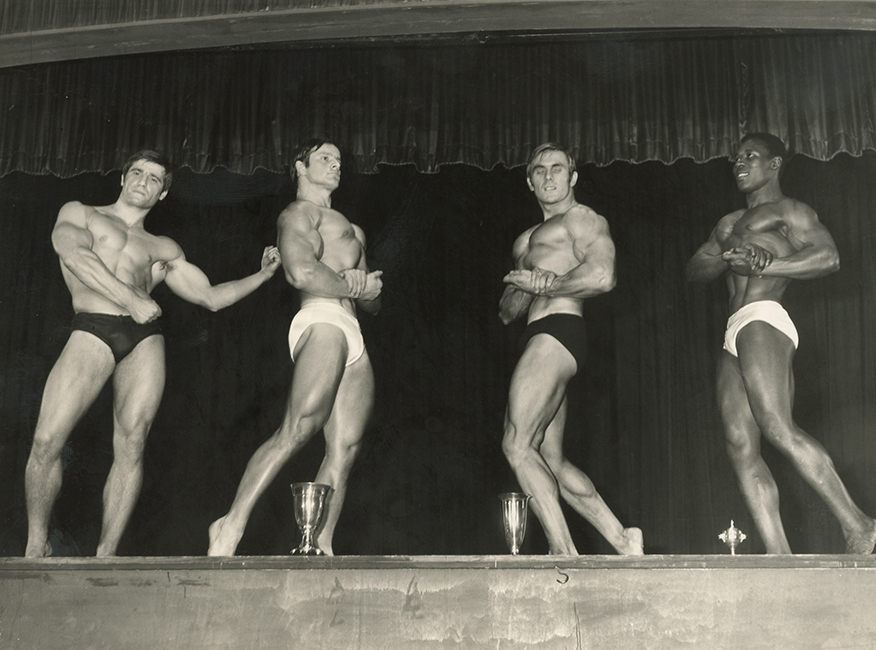 Nineteenth Competition, “Most Beautiful Athlete of Europe, 1967”
Nineteenth Competition, “Most Beautiful Athlete of Europe, 1967”
(Left to right) Serge Jacobs (Belgium), Janko Rudman (Sweden) , Raymond Everlet, (France), and Alain Babel (France)
Studio Arax

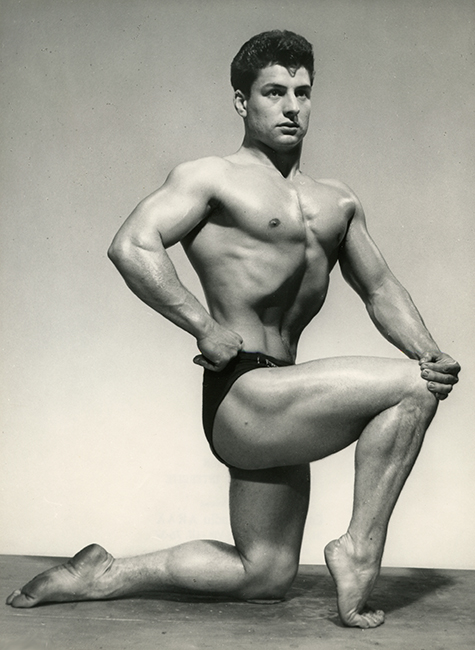
Bernard Boulogne, Paris, 1955
Studio Arax
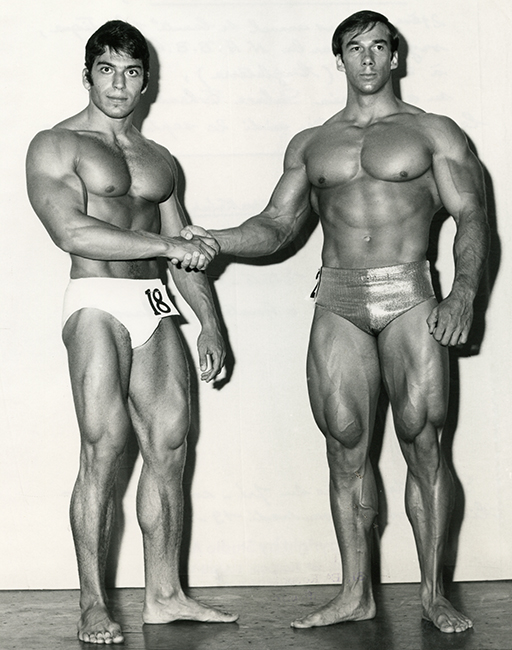 Mister Universe, London, 1969
Mister Universe, London, 1969
Khaled Beyrakdar, no. 18, (Lebanon) and Boyer Coe (USA)
Studio Arax
CONTEXT
View Photo Index
BIOGRAPHY
Krikor Djololian is regarded as one of the renowned Armenian photographers of the 20th century. His photographic output spanning over four decades tapped into a wide range of subject matter. However, it is his photographs of professional bodybuilders that commanded international recognition and garnered high accolades from the emerging physical culture movement in Europe and the United States. As his history reveals, Krikor Djololian’s early exposure to sports in Constantinople prior to the collapse of the Ottoman Empire had a profound impact on his professional life as a photographer in Paris.
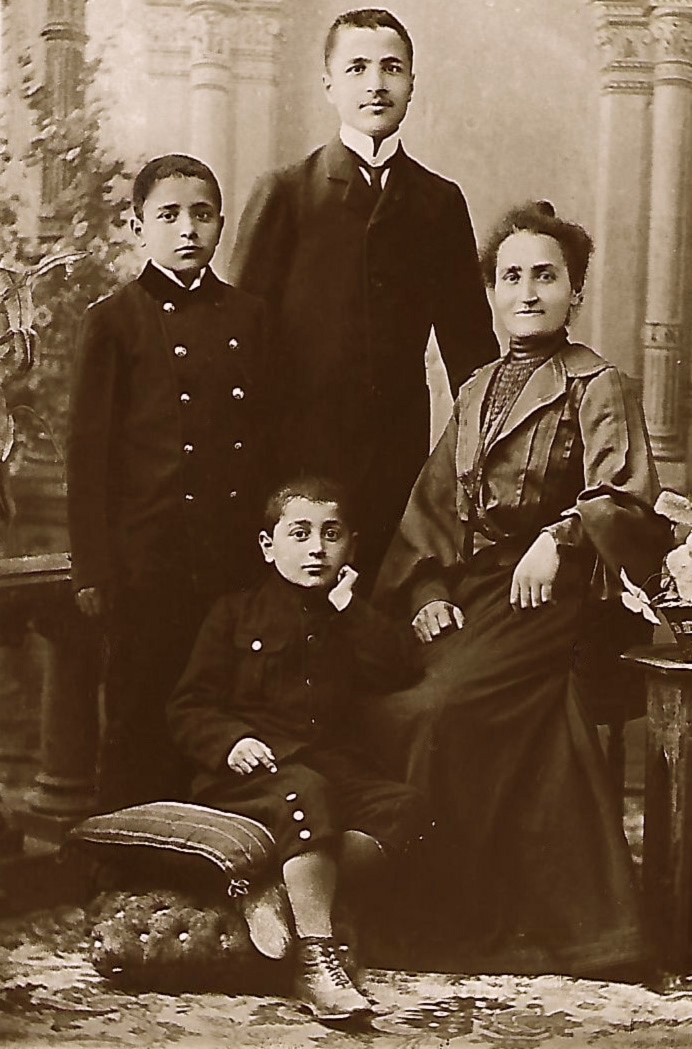
Family portrait of the Djololian family, ca. 1905. Miriam, Hagop Sirouni, Haig and Krikor (seated) (Krikor Djololian Collection)
Krikor Djololian was born in Adapazar, Turkey on February 27, 1897. During the early 1900s, his widowed mother, Miriam, moved the family to Constantinople in order to seek employment that would afford her sons the finest level of education at the prestigious Essayan and Guetronagan School. The eldest son, Hagop Sirouni (1890-1973), rose to prominence as a journalist, writer and editor of several newspapers. Haig, the middle son described as a very talented young man, was destined to have a great athletic career. As the youngest of three brothers, Krikor Djololian immersed himself into sports and scouting events. Thus, athleticism and sporting competitions embraced by the Djololian brothers played a significant role in shaping Krikor’s personal and professional life.
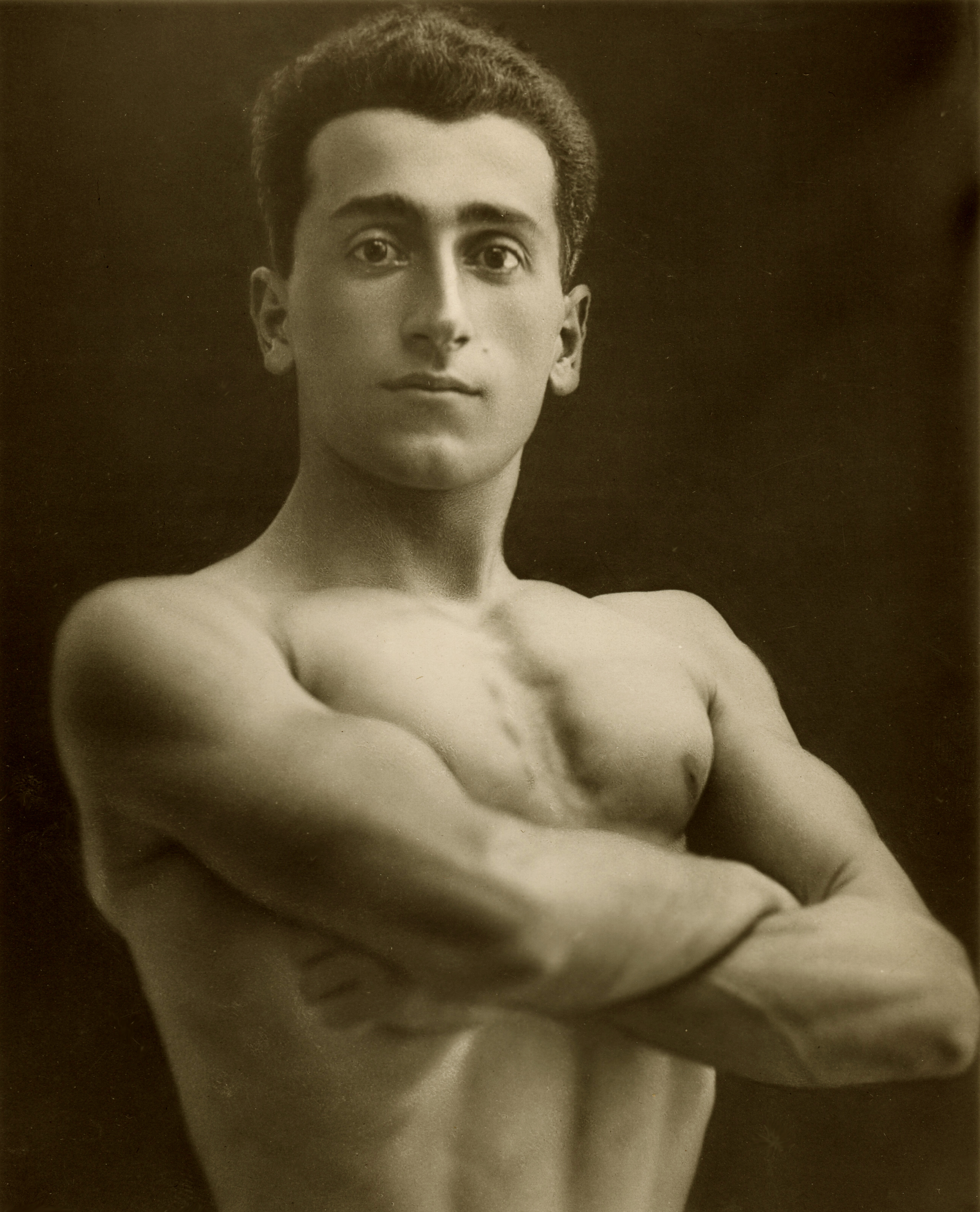
Krikor Djololian as an athlete, ca. 1920 (Krikor Djololian Collection)
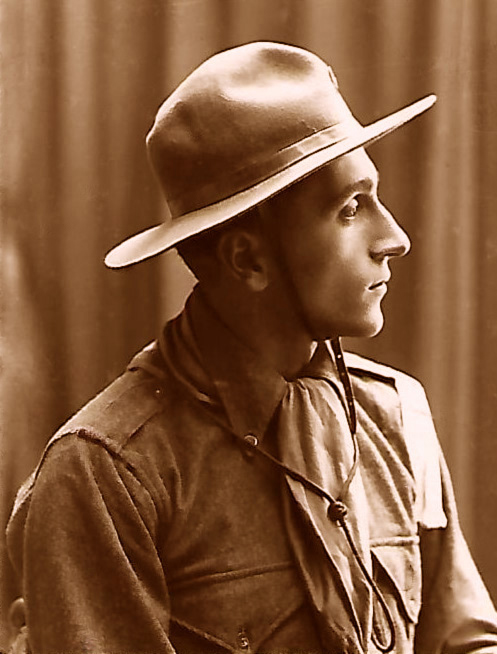
Krikor Djololian as a scout master, ca. 1920 (Krikor Djololian Collection)
The Armenian Genocide of 1915 devastated and altered the destinies of the Djololian brothers. At the start of the Genocide, Hagop Sirouni was identified as one of the Armenian intellectuals targeted for arrest on April 24, 1915. He went into hiding for three years with a Greek family in Constantinople to avoid execution like so many of his compatriots. Having survived the Genocide, Hagop Sirouni left for Romania in 1920 and developed an outstanding literary career that spanned several decades. He is described as “a multitalented man of letters: a fairytale writer, a critic, a historian, a social commentator and an intellectual.” Tragically, with a different fate in store, Haig Djololian’s life ended when he was assassinated while serving in the Ottoman army during World War I. Krikor Djololian was arrested and deported in 1915. After the war ended, he returned to Constantinople and was reunited with his brother and mother. Very little of the events surrounding his deportation and survival during those traumatic years is known. His son, Patrice, has noted that his father rarely talked about his youth – “it was as if he concealed that time under a black canvas.”
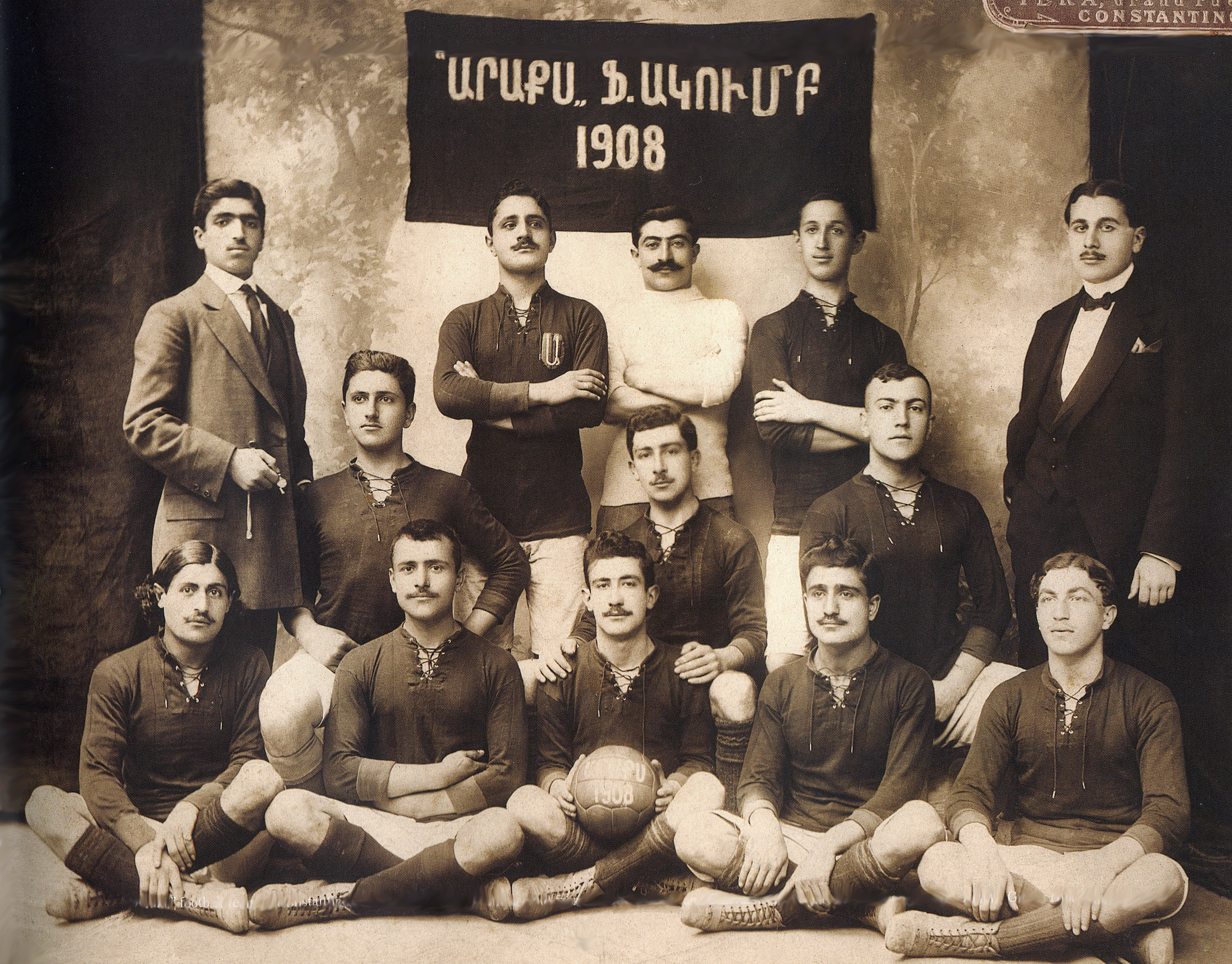
Araks football team of Constantinople. Haig Djololian, brother of Krikor Djololian is second from the left (seated) (Krikor Djololian Collection)
After the Genocide, the formation of a pan-Armenian sports association proved to be a significant development in the Armenian community of Constantinople. The Armenian General Athletic Union and Scouts (Homenetmen) was launched in November 1918 by prominent members in the Armenian community with the active support of Hagop Sirouni. The motto of Homenetmen – “Rise and Raise” or “Elevate Yourself and Elevate Others with You” – influenced Krikor Djololian’s decision to assume a leadership role within the Armenian community of survivors healing from the ravaging effects of the Genocide. As with many “stateless nations,” Nicholas Palluau and Marie Caquel note that “sports are an important vector of identity and a factor of national cohesion.”
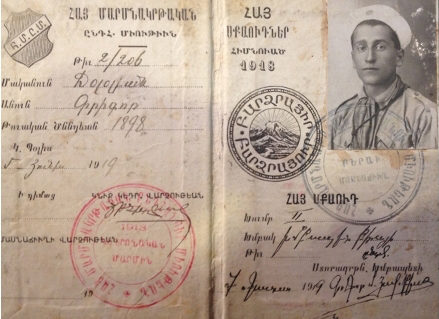
Krikor Djololian’s scouting membership card, 1918 (Krikor Djololian Collection)
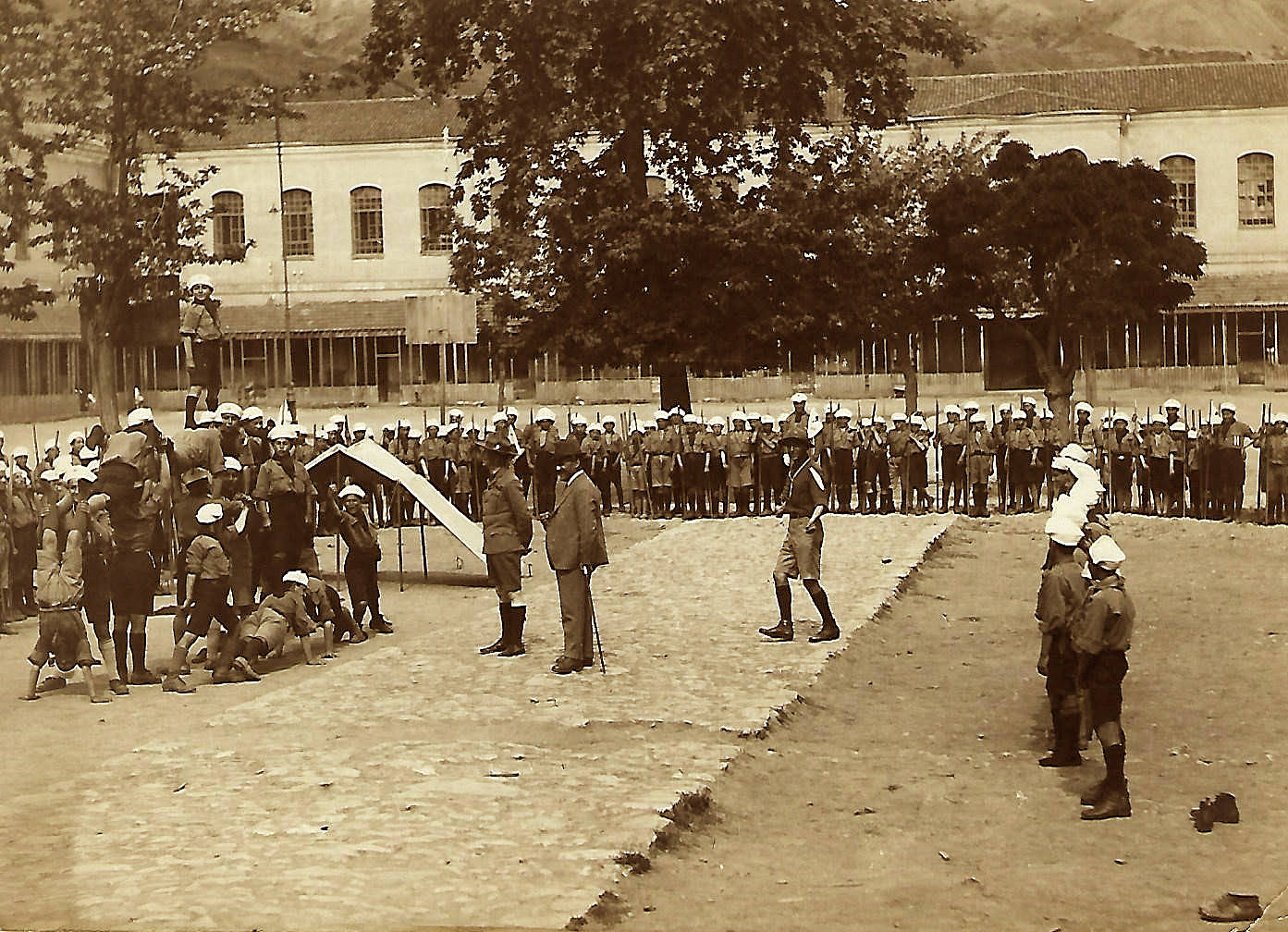
The annual inter-orphanage Olympic games, July 1921 (Krikor Djololian Collection)
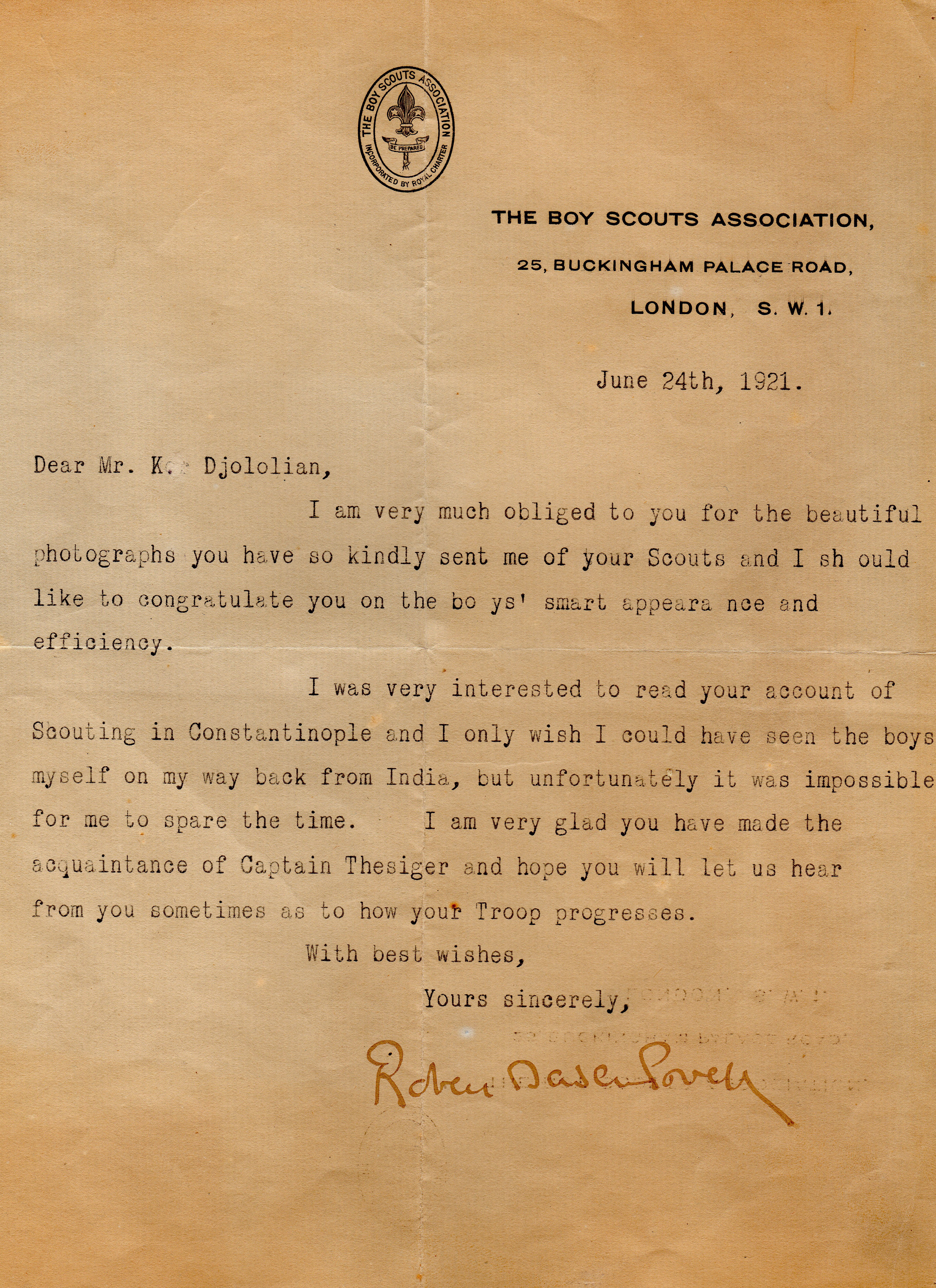
Letter from Lord Baden-Powell to Krikor Djololian, June 24, 1921 (Krikor Djololian Collection)
From 1918 to 1922, Krikor’s time in Constantinople was devoted to the organization of athletic competitions as well as leading a troop of several hundred Armenian scouts. It was during this period that he began experimenting and developing his photographic skills. It remains unclear how or with whom he may have acquired these skills. Many of his images during this period portrayed scouting events and athletic competitions. In 1921, Krikor received a congratulatory letter from Lord Baden-Powell, a British army officer, writer, founder and first chief scout of the Boys Scouts Association. In response to Krikor’s description of the state of Armenian scouting in Constantinople which was accompanied with photographs of athletic events, Lord Baden-Powell praised Krikor’s scouts for their “intelligence” and “efficiency.” Undoubtedly, Krikor’s photographs personified the rise of athleticism within the Armenian community.

Athletes from the Pera branch of the Armenian General Athletic Union. Noubar Arapyan, Gabriel Qeshishyan and Krikor Djololian (right), ca. 1919 (Krikor Djololian Collection)
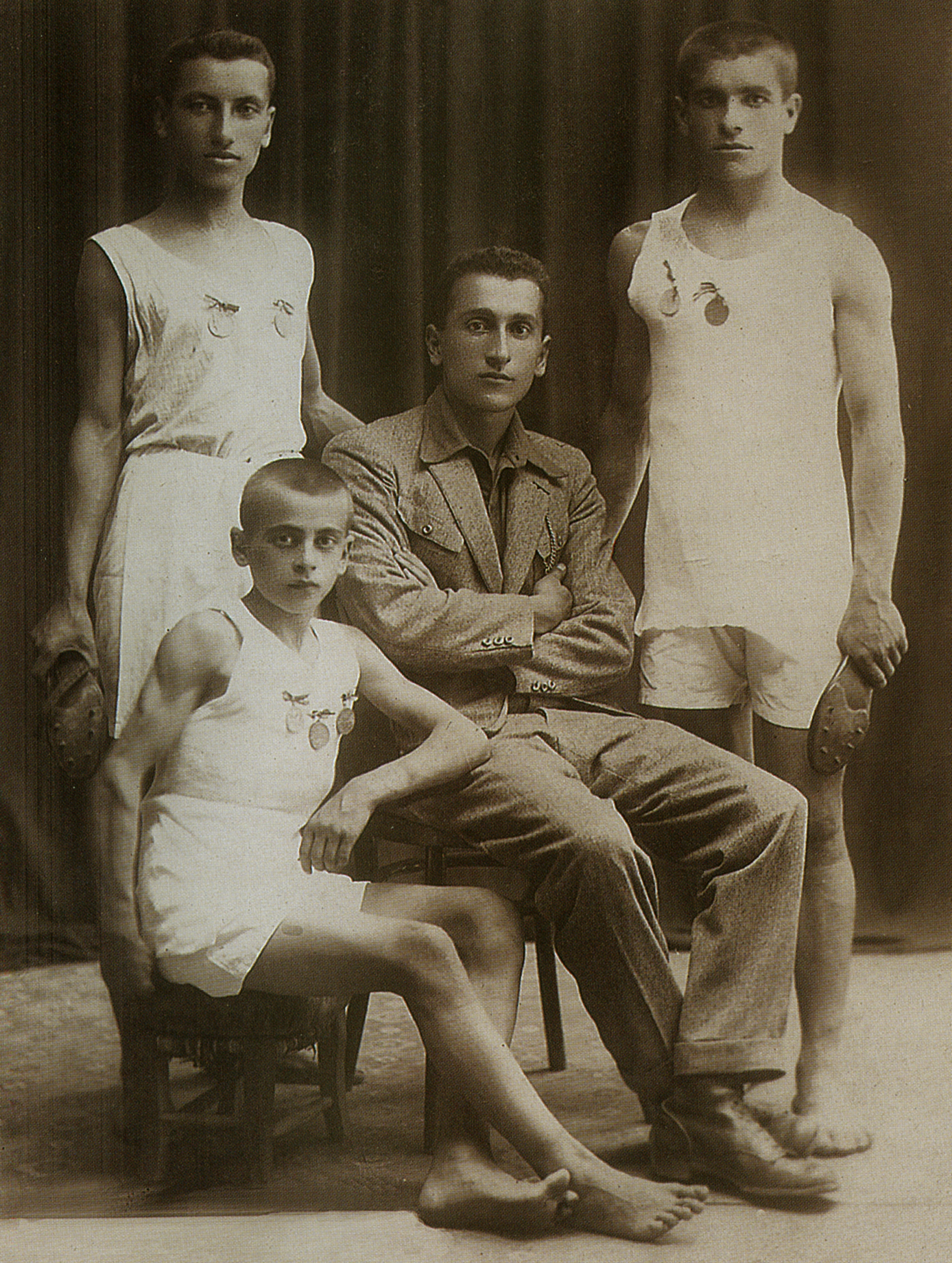
Krikor Djololian with orphans from the Constantinople National Central Orphanage, 1921 (Krikor Djololian Collection)
With the temporary occupation of Constantinople by the Allied troops ending on the heels of the Treaty of Lausanne, Krikor and his mother immigrated to Paris in 1922. Sometime before World War II, he became a naturalized French citizen, married, and had three sons. Sports and photography had provided a measure of success in Constantinople for Krikor. Hence, he embarked on a professional career as a photographer in Paris. He continued to organize athletic competitions within the Armenian French community. For his dedication and commitment to the advancement of sports, Krikor was awarded the Gold Medal from the French Ministry of Youth and Sports.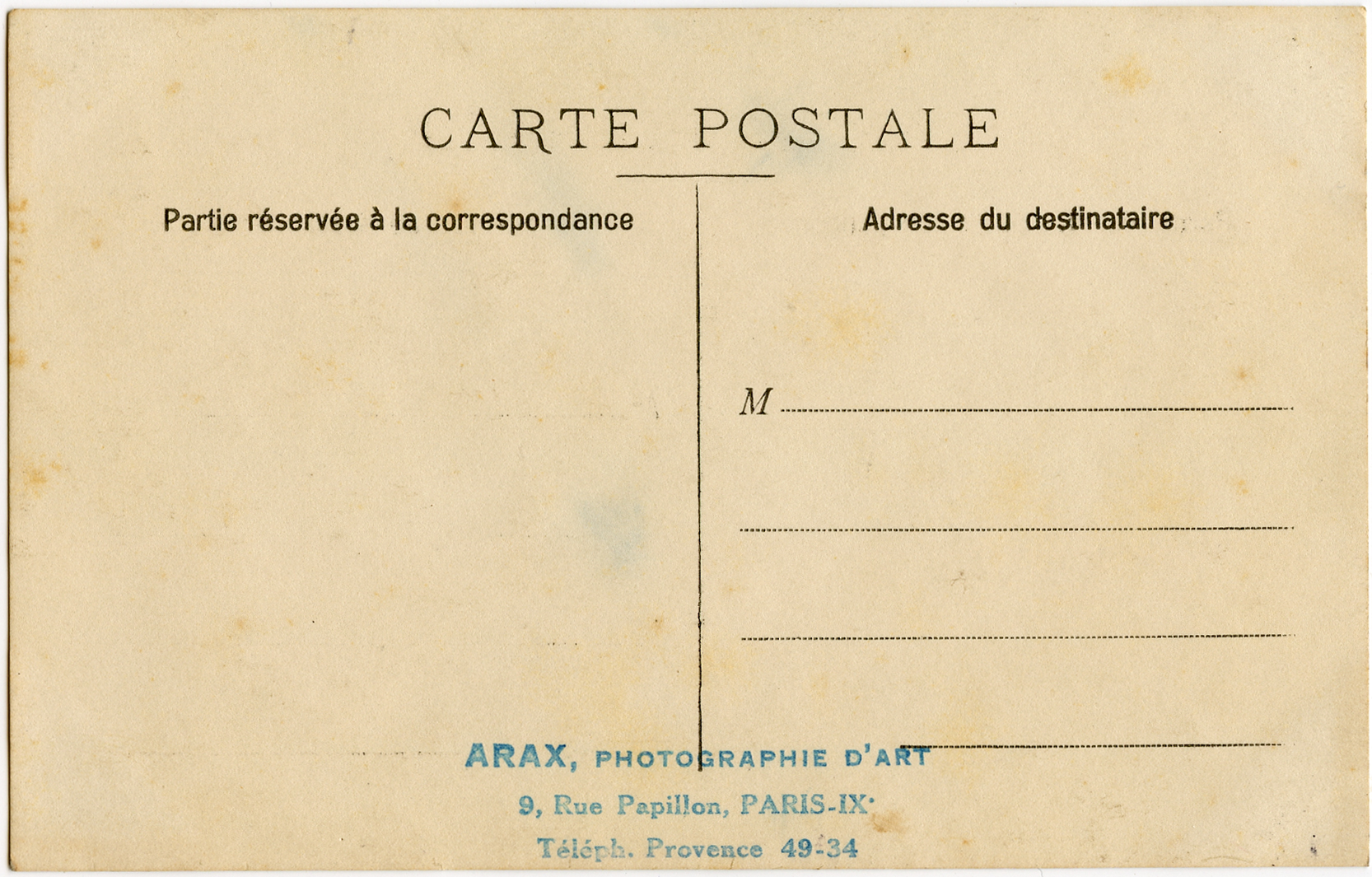
Once Krikor established himself in Paris in the 1920s, he opened a studio on 9 Rue Papillon which he named “Studio Arax,” and in the early 1930s he moved his studio to 31 Boulevard Raspail where he practiced photography until his death in 1975. Initially, he worked as a photojournalist collaborating with many Armenian and Parisian publications. Immersed in Parisian life, he not only engaged in studio portrait photography but he captured images of major events such as the artistic milieu of the Roaring Twenties, the Montparnasse balls of the 1920s, dancing championships of the 1930s, and the liberation of Paris in 1944 with Charles De Gaulle and Winston Churchill. Within the Armenian community, Krikor was privileged to witness and to photograph prominent figures and historic events such as the burial of General Antranik, the funeral of Komitas’ father, the 1936 visit of Franz Werfel, and the eminent French Armenian singer, Charles Aznavour, photographed as early as age four.
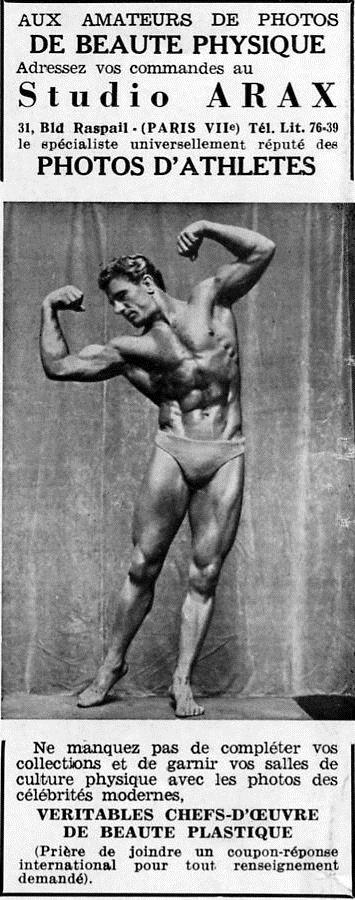
Advertisement for Studio Arax (Krikor Djololian Collection)
Krikor’s passion for athleticism led him to embrace the “physical culture movement” in the 1930s. The “ideal of athleticism and physical beauty dating back to classical Greece” was the cornerstone of the physical culture movement which influenced Krikor to specialize in the photography of professional bodybuilders. As noted by Thomson Gale:
The physical culture movement promoted fitness, health, and muscular strength through regular exercise, participation in sports, and proper nutrition. It had its origins in the eighteenth-century revival of interest in classical athleticism, especially the artistic emphasis on the muscular form, and reached its height in the United States, Britain, and Europe from 1880 until 1930. Since the 1930s the physical culture movement developed into the sport of modern bodybuilding, with the emphasis gradually shifting from exercise done for the sake of strength and fitness to exercise as a means of shaping the body for aesthetic effect.
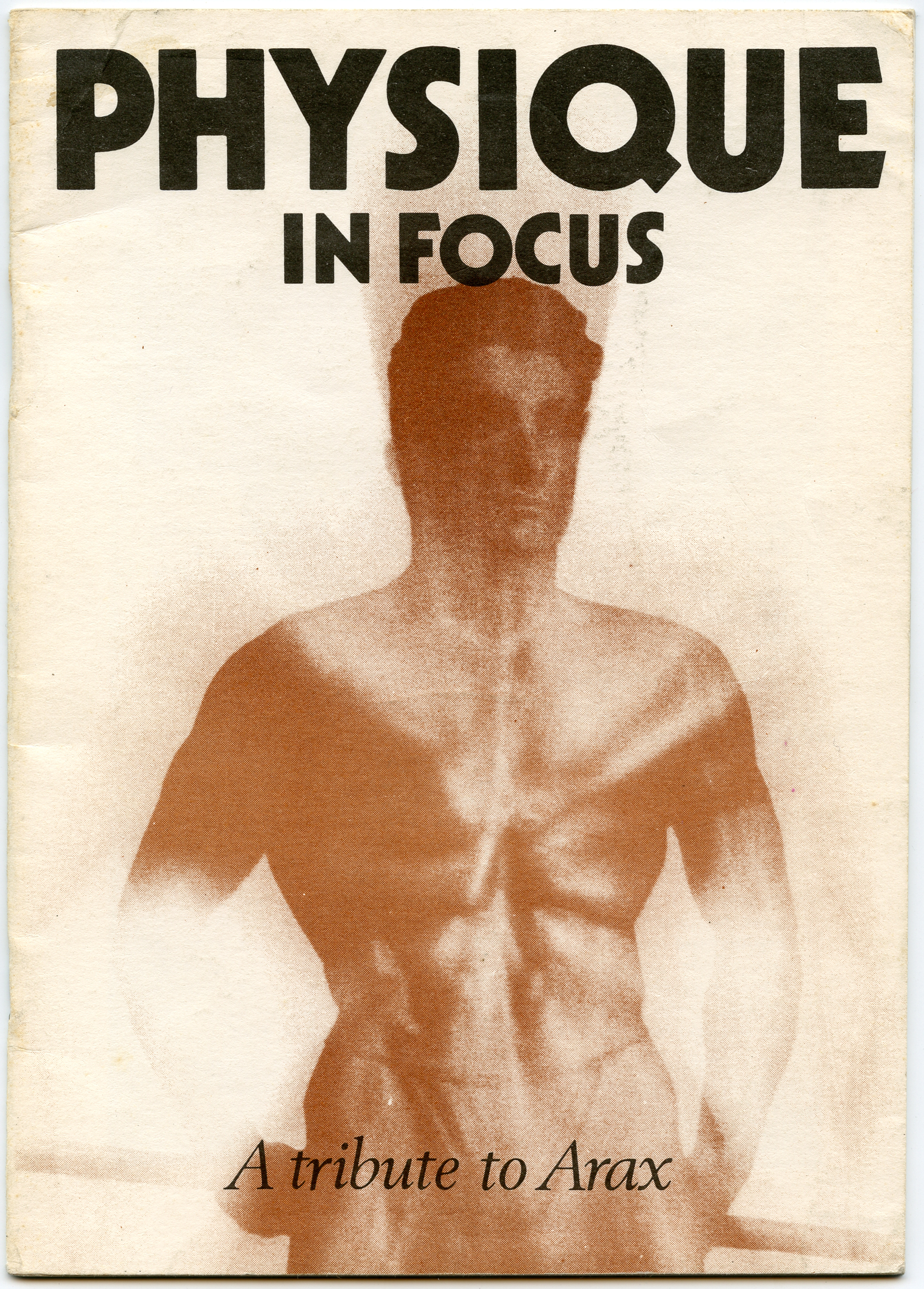
A tribute to Arax, in ‘Physique In Focus,’ ca. 1975 (Malikian Collection)
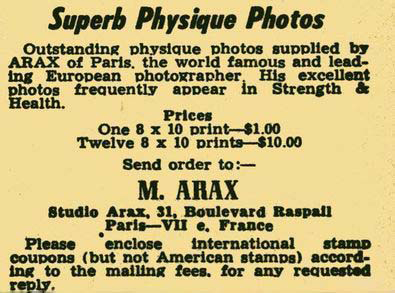
Advertisement for Studio Arax (Krikor Djololian Collection)
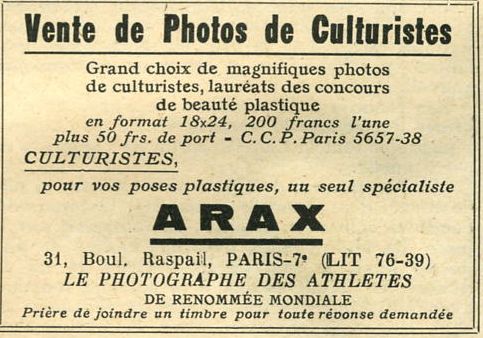
French advertisement for Studio Arax (Krikor Djololian Collection)
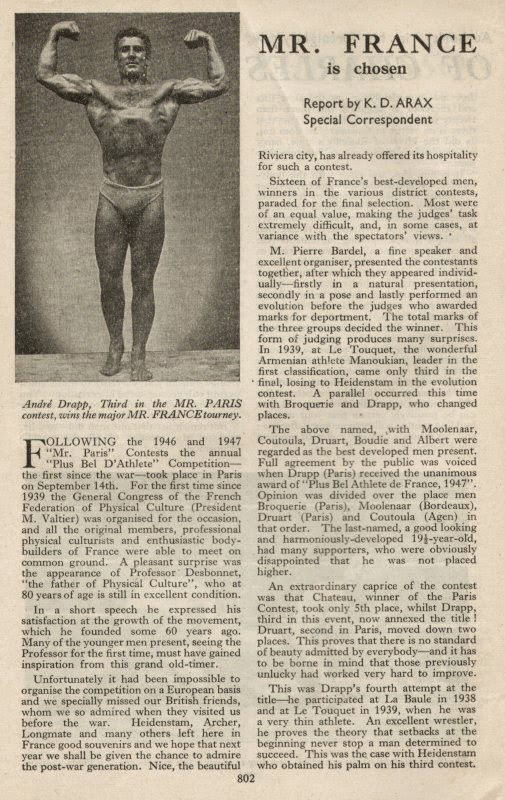
Article by Krikor Djololian in Health & Strength magazine, October 19, 1947
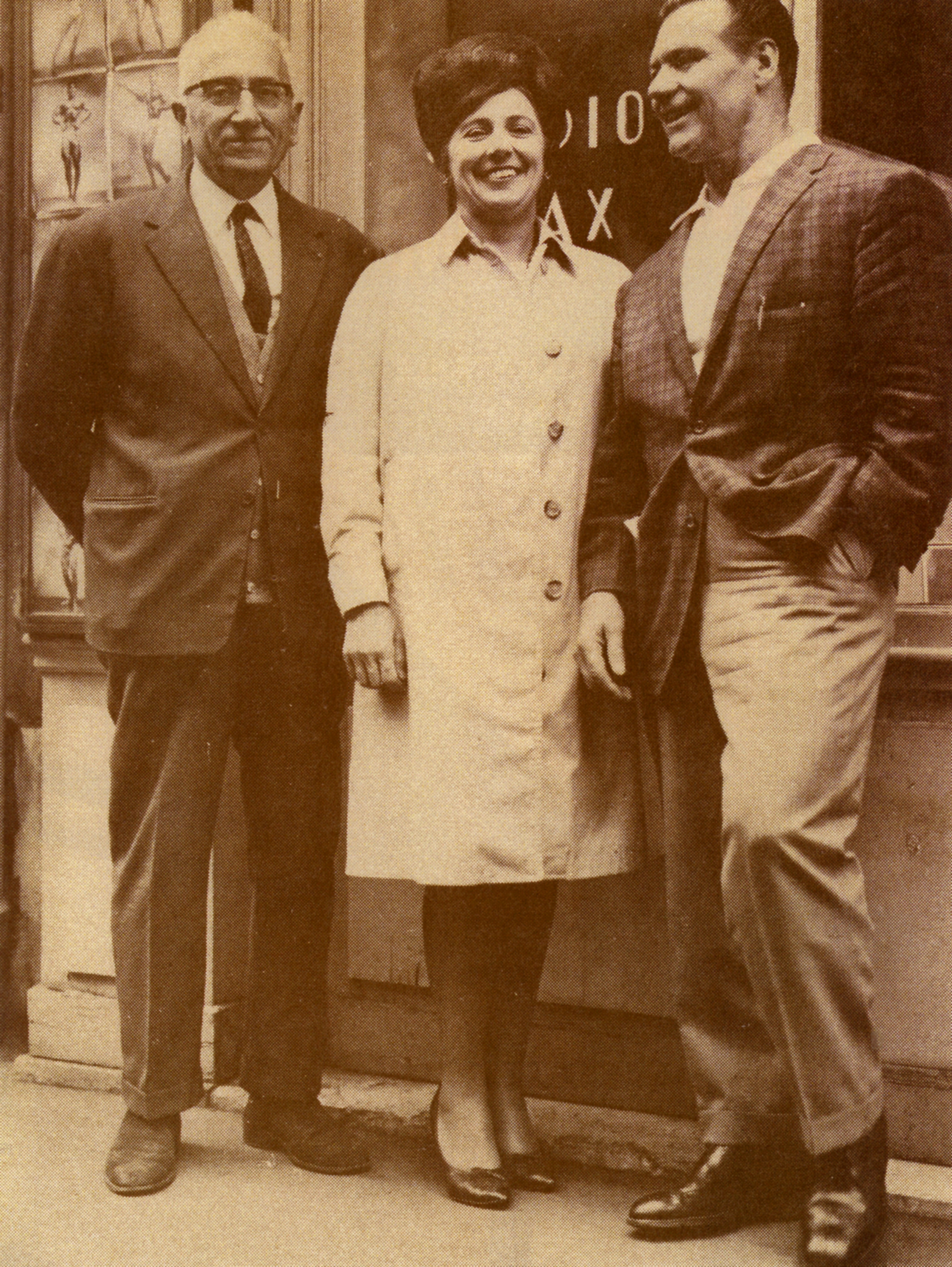
Krikor Djololian with bodybuilder John Grimek and his wife, Angela, outside of Studio Arax in Paris, ca. 1960
The ranking criteria of “symmetry,” “muscularity” and “conditioning” which had been used by judges at bodybuilding competitions were reflected in Krikor’s photographs of professional bodybuilders. His images of scantily clad or at times nude bodybuilders in flexing physiques reflected the ideal body proportions of ancient Greek and Roman statues. Among some of the world-renowned bodybuilders photographed by Krikor were Steve Reeves (Hercules at the cinema), Arnold Schwarzenegger (Mr. Universe), Robert Duranton, and as a young bodybuilder the actor Sean Connery. Krikor traveled extensively to all the major competitions in Europe where he “immortalized” the champions from these events. He was regarded as the official photographer of bodybuilders, and his studio became the “mecca for bodybuilders the world over.” From 1934 to 1975, Krikor contributed images of bodybuilders and periodically served as a correspondent for the British magazine “Strength and Health” which was one of the earliest publications devoted to fitness and bodybuilding.
Krikor Djololian passed away on June 26, 1975. He left behind an extraordinary legacy. He is remembered for his prolific archive of portrait photography as well as his images that documented important events in French and Armenian history. However, it is his captivating photographs of professional bodybuilders from the early period of the physical culture movement that afforded him worldwide recognition. Krikor Djololian is undeniably one of the outstanding Armenian photographers from the twentieth century whose imprint in the history of Armenian photography will be lasting and treasured.
Patrice Djololian is credited with providing the family history. I extend my appreciation for his collaboration.
Copyright of the images in this exhibition remains with the Djololian family and may not be reproduced without their permission.
Photographs of the bodybuilders in the exhibit section are in the Malikian Collection. They may not be reproduced or transmitted in any form or means without prior consent of Joseph Malikian.
- https://auroaprize.com/en/stories/detail/regular/10389/patrice-djololian
- https://journals.openedition.org/hommesimigrations/2910
- Nicholas Palluau, “Between nation and religion. Scouting and the organization of young immigrants (1920-1950),” in Cahiers de la Méditerranée, No. 78, 2009.
- https://en.wikipedia.org/wiki/Homenetmen
- https://en.wikipedia.org/wiki/Bodybuilding
- https://homodesiribus.blogspot.com/2012/07/le-studio-arax-paris-france.html
Arax was devoted to bodybuilding and for forty years – spanning from the mid-thirties until the mid-seventies – his pictures were amongst the most popular in physical culture magazines. Arax would travel to most major competitions in Europe and always produced good on-the-spot pictures although the conditions were far from ideal for photography.
It was in his studio in the Boulevard Raspail, however, that he came into his own with the subtle lighting which emphasized the muscularity of his subjects, rather than the art of the photographer. He shunned over dramatic studies, fancy backgrounds, intriguing props, or complicated compositions – the physique alone was what mattered to Gregor and he was extremely careful with every picture he took.
A Tribute to Gregor Arax
Physique in Focus, ca. 1977



